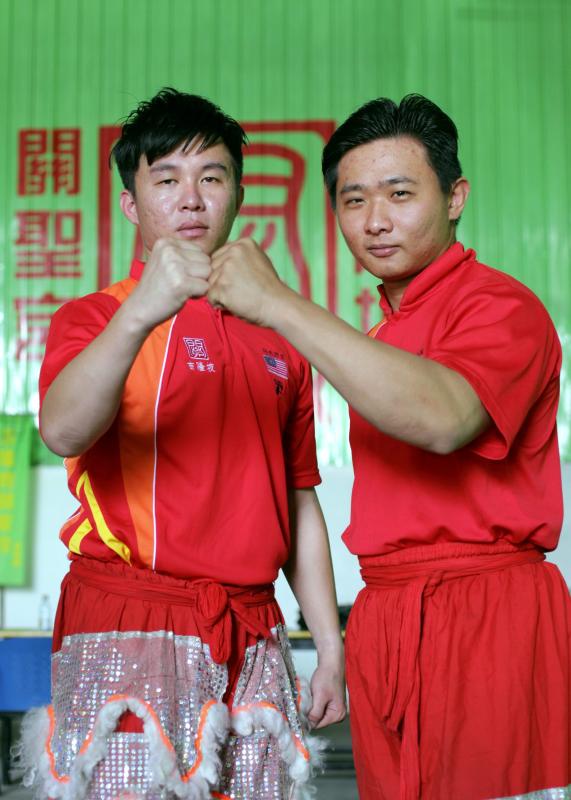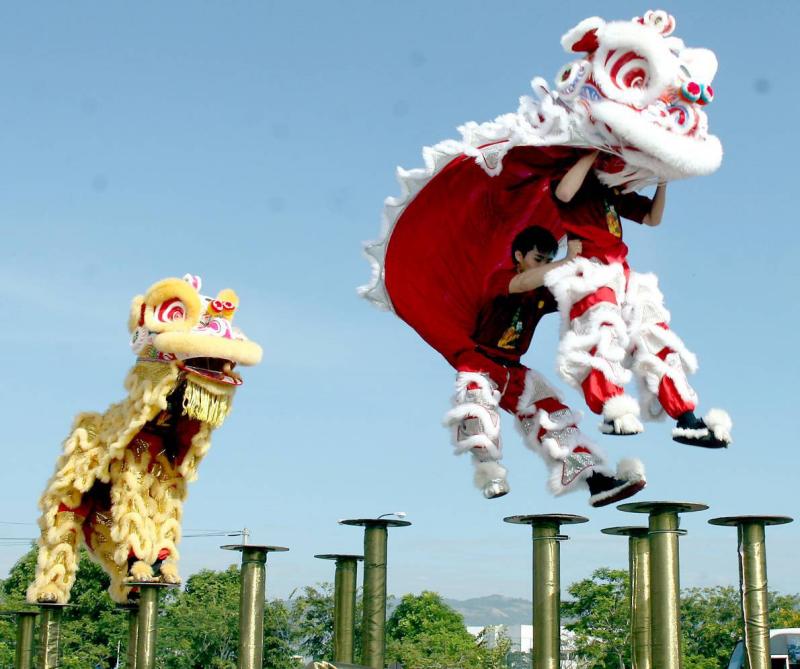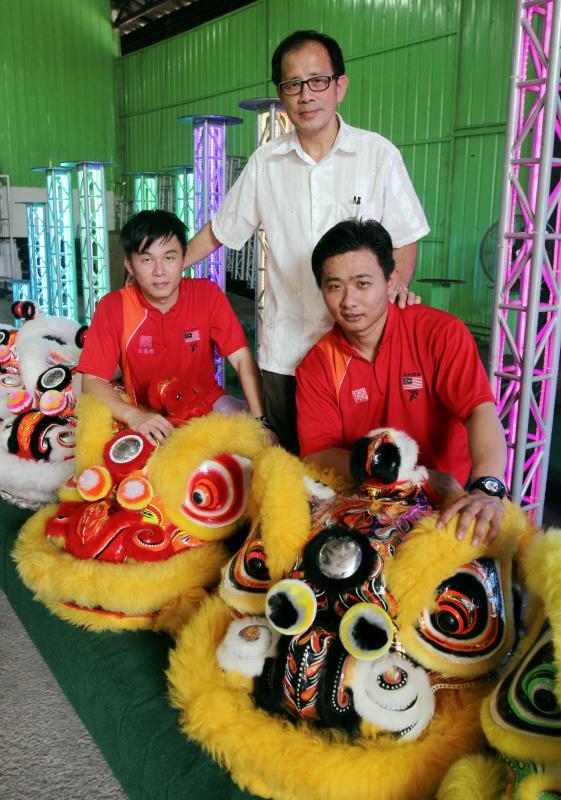By LIM MAY LEE
alltherage@thestar.com.my
LION dancers are seriously passionate about their craft, and none more so than the legendary duo of Chong Kok Fu and Si Tiam Yong from the renowned Kun Seng Keng lion and dragon dance association.
As a team, Chong and Si – the tail and head of the lion respectively – have contributed to 19 of the 66 world championship titles the association has won. They are so legendary that a movie has been made about them, The Great Lion – Kun Seng Keng, which will be hitting our screens on May 29.
Though they’re now veritable superstars in the international lion dance community, success didn’t come easy for Chong, 29, and Si, 26, who both retired from competition in 2009 to focus on training the next generation of lion dancers.
They both started their lion dance training at the tender age of 12, back in a time when safety mats weren’t exactly a huge priority. Lion dance training is never a walk in the park to begin with (more on that later), but Chong and Si stuck to it, and they started to form a formidable partnership.
It all started in 2006, when the two were first picked to represent the Muar, Johor Baru-based Kun Seng Keng in a tournament. But with the troupe enjoying a winning streak across 15 championships at the time, the pressure got to the pair and they crashed out.

Si (left) and Chong’s story will be immortalised in the upcoming movie The Great Lion – Kun Seng Keng.
Things didn’t get any easier after that. Their next tournament for Kun Seng Keng was the Genting World Lion Dance Championship – which is like the World Cup of lion dance – and both of them suffered injuries right before the championship.
“I had fallen down and hurt my lower back,” recalled Si. “I could barely move.” Chong, on the other hand, had injured his chin badly. There was only a month to go before the competition, and doctors had advised Si to stop his lion dance training for three months.
Si, however, was determined to compete at the World Championship. He maintained a regular exercise routine to maintain his fitness levels without lion dance training, which allowed him to be just about fit enough to compete when the time came. The rest, as they say, is history. The pair won the competition, bringing Kun Seng Keng its 21st world title – and the first of many for the Chong and Si.
Their inspiring story has not only spawned The Great Lion, but also a documentary.
The duo feel the movie will ensure that the tradition of lion dance stays relevant to young poeple. “I hope that through this movie, Malaysia’s legacy of lion dance will be known to the world,” said Chong.
“A lot of people think lion dance is for old people, but now there is a chance to show everybody that it’s something young people like to do too,” added Si.

Do or dare: The Kun Seng Keng Lion and Dragon Dance Association are internationally-renowned for their amazing choreography.
No pain, no gain
If you think lion dance is all fun and games, think again. Training is gruelling, and not to mention potentially dangerous. Most teams now have safety mats at their training centres, but injuries still happen when you’re performing acrobatics balanced on pillars up to eight feet high.
And the amount of thought that goes into planning lion dance choreography, which has to have a storyline, is staggering.
“We cannot just jump up and down. It needs to suit the story!” said Chong. “We have to brainstorm as a team to find ways to be unique so we can stand out in competitions.”
But the most important thing is the audience; and with audiences becoming increasingly sophisticated, lion dance troupes have had to get flashier costumes and perform on taller pillars as the years go by. “Today, without props, we wouldn’t be able to excite the audience,” said Chong.
All that hard work pays off, however, when the pair sees the faces of amazement among their audiences.
One of their fondest memories was of a lion dance championship in Canada, the first of its kind outside of Asia. The people there didn’t seem to take them very seriously at first, but after Chong and Si won the championship, a local came up and spoke to them excitedly.
“I couldn’t understand what he said because I don’t understand much English!” said Chong with a laugh. “But I think he enjoyed it, because he gave us a donation of a hundred Canadian dollars (RM300).”

Kun Seng Keng Lion and Dragon Association’s chairman, Tan Chong Hing (middle), with Si Tiam Yong (left) and Chong Kok Fu.
The best of the best
While the name Kun Seng Keng is almost revered in lion dance circles now, its beginnings were far less glittery. When it was founded in 1988, they barely had any money to travel for competitions and they didn’t have their own training space. “It wasn’t easy. It involved a lot of money and effort,” reminisced Kun Seng Keng chairman Tan Chong Hing.
What they did have in abundance, though, was perseverance and passion. “I told them, even if we start from the bottom, as long as we put in the effort, we can make it and become a big team,” added Tan.
The troupe struggled to find places to train, and had to resort to borrowing training grounds from other associations, while sponsors helped provide the equipment they needed.
Eventually, they managed to secure an international victory in Hong Kong, where Malaysian teams were still considered underdogs at the time.
Success breeds success, and it wasn’t long before Kun Seng Keng became the team to beat on the international stage. They’ve won the World Lion Dance Championship, held annually in Genting Highlands, multiple times – including the most recent edition earlier this year. It was their tenth World Championship win.
The competition is like the World Cup of the lion dance world. According to Chong Kok Fu, one of Kun Seng Keng’s most successful performers, taking part in it is “every lion dancer’s dream.”
But apart from winning trophies and gaining international acclaim, what really drives the people at Kun Seng Keng is their passion for keeping lion dance culture alive. “This is a unique Chinese tradition that we must sustain,” said Tan.
They’re also keen to take their passion as far as possible, geographically speaking. They’ve set up training centres in seven locations in Peninsular Malaysia, and have opened one in Sabah, with a Sarawakian branch on the way.
They’ve gone international as well, creating the International Kun Seng Keng Lion and Dragon Dance Alliance, which covers nine countries – Malaysia, Singapore, Indonesia, China, Taiwan, Hong Kong, Brunei, Philippines and Macau.


Tell us what you think!